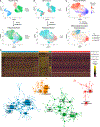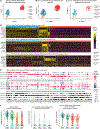Positional influence on cellular transcriptional identity revealed through spatially segmented single-cell transcriptomics
- PMID: 37348462
- PMCID: PMC10424188
- DOI: 10.1016/j.cels.2023.05.003
Positional influence on cellular transcriptional identity revealed through spatially segmented single-cell transcriptomics
Abstract
Single-cell RNA sequencing (scRNA-seq) is a powerful technique for describing cell states. Identifying the spatial arrangement of these states in tissues remains challenging, with the existing methods requiring niche methodologies and expertise. Here, we describe segmentation by exogenous perfusion (SEEP), a rapid and integrated method to link surface proximity and environment accessibility to transcriptional identity within three-dimensional (3D) disease models. The method utilizes the steady-state diffusion kinetics of a fluorescent dye to establish a gradient along the radial axis of disease models. Classification of sample layers based on dye accessibility enables dissociated and sorted cells to be characterized by transcriptomic and regional identities. Using SEEP, we analyze spheroid, organoid, and in vivo tumor models of high-grade serous ovarian cancer (HGSOC). The results validate long-standing beliefs about the relationship between cell state and position while revealing new concepts regarding how spatially unique microenvironments influence the identity of individual cells within tumors.
Keywords: RNA sequencing; genomics; oncology; ovarian cancer; scRNA-seq; single-cell transcriptomics; spatial transcriptomics; spatially resolved transcriptomics.
Published by Elsevier Inc.
Conflict of interest statement
Declaration of interests The authors declare no competing interests.
Figures







Similar articles
-
Lamination-based organoid spatially resolved transcriptomics technique for primary lung and liver organoid characterization.Proc Natl Acad Sci U S A. 2024 Nov 12;121(46):e2408939121. doi: 10.1073/pnas.2408939121. Epub 2024 Nov 8. Proc Natl Acad Sci U S A. 2024. PMID: 39514315 Free PMC article.
-
Identification of Niche-Specific Gene Signatures between Malignant Tumor Microenvironments by Integrating Single Cell and Spatial Transcriptomics Data.Genes (Basel). 2023 Oct 31;14(11):2033. doi: 10.3390/genes14112033. Genes (Basel). 2023. PMID: 38002976 Free PMC article.
-
Computational solutions for spatial transcriptomics.Comput Struct Biotechnol J. 2022 Sep 1;20:4870-4884. doi: 10.1016/j.csbj.2022.08.043. eCollection 2022. Comput Struct Biotechnol J. 2022. PMID: 36147664 Free PMC article. Review.
-
Single-cell RNA sequencing in stroke and traumatic brain injury: Current achievements, challenges, and future perspectives on transcriptomic profiling.J Cereb Blood Flow Metab. 2024 Dec 9:271678X241305914. doi: 10.1177/0271678X241305914. Online ahead of print. J Cereb Blood Flow Metab. 2024. PMID: 39648853 Free PMC article. Review.
-
Single Cell Sequencing and Kidney Organoids Generated from Pluripotent Stem Cells.Clin J Am Soc Nephrol. 2020 Apr 7;15(4):550-556. doi: 10.2215/CJN.07470619. Epub 2020 Jan 28. Clin J Am Soc Nephrol. 2020. PMID: 31992574 Free PMC article. Review.
Cited by
-
Drug resistance and tumor heterogeneity: cells and ensembles.Biophys Rev. 2025 May 31;17(3):759-779. doi: 10.1007/s12551-025-01320-y. eCollection 2025 Jun. Biophys Rev. 2025. PMID: 40727661 Free PMC article. Review.
-
Linking Metastatic Behavior and Metabolic Heterogeneity of Circulating Tumor Cells at Single-Cell Level Using an Integrative Microfluidic System.Adv Sci (Weinh). 2025 Apr;12(14):e2413978. doi: 10.1002/advs.202413978. Epub 2025 Feb 17. Adv Sci (Weinh). 2025. PMID: 39960842 Free PMC article.
-
Lamination-based organoid spatially resolved transcriptomics technique for primary lung and liver organoid characterization.Proc Natl Acad Sci U S A. 2024 Nov 12;121(46):e2408939121. doi: 10.1073/pnas.2408939121. Epub 2024 Nov 8. Proc Natl Acad Sci U S A. 2024. PMID: 39514315 Free PMC article.
References
-
- Bissell MJ, Kenny PA, and Radisky DC (2005). Microenvironmentalregulators of tissue structure and function also regulate tumor induction and progression: the role of extracellular matrix and its degrading enzymes. Cold Spring Harb. Symp. Quant. Biol. 70, 343–356. 10.1101/sqb.2005.70.013. - DOI - PMC - PubMed
Publication types
MeSH terms
Grants and funding
LinkOut - more resources
Full Text Sources

